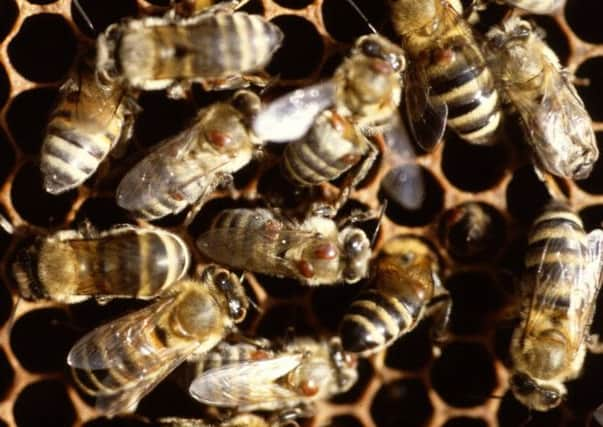Honeybee dancing offers vital environmental clues


New research has shown a special waggle dance acted out by the insects can offer vital clues to the state of the local environment.
Scientists at the University of Sussex say the jiggling motions performed by worker honeybees to tell hive-mates where to find the best pollen and nectar can also pinpoint the healthiest areas of land.
Advertisement
Hide AdAdvertisement
Hide AdResults of the two-year study suggest costly measures to set aside farmland to grow wild flowers can benefit bees and other crucial pollinators.
Researchers at the university’s Laboratory of Apiculture and Social Insects (Lasi) spent two years filming honeybees in glass-fronted observation hives.
They studied a total of 5,484 waggle dances, which they decoded to discover where bees were gathering their food.
The angle of their dances conveys information about the direction of resources while the duration reveals the distance.
Dance characteristics can be measured in a matter of minutes using a protractor and timer.
By combining the dance data with maps of land use and the foraging range of honeybees, the researchers were able to create a survey of 36 sq miles.
The landscape was divided into urban, rural or rural land under five different levels of government-funded agri-environment schemes (AESs).
The study showed the most plentiful sites for food-gathering were rural lands in the higher-level AESs. The best site was the only national nature reserve in the area.
Advertisement
Hide AdAdvertisement
Hide AdLead researcher Dr Margaret Couvillon said: “Usually efforts to help wildlife takes two approaches. One is to set aside important areas like national parks or national nature reserves.
“Another approach is to make existing areas more wildlife-friendly, like the agri-environment schemes.
“Here we have let the bees tell us which practices work and what areas are good for them.
“The honeybee is acting as an ‘indicator’ species pointing to healthy landscapes.
“The honeybee is a generalist forager, so landscapes used by honeybees are good for a wide range of pollinators.
“The waggle dance is, therefore, more than just honeybee behaviour. It is a powerful tool for ecology and conservation, providing unique information that may help to evaluate landscapes and human efforts to sustain a more wildlife-friendly world.”
In the past 20 years the European Union has spent £33.4 billion on AESs, which aim to improve the rural landscape through measures such as creating areas for nature around crop fields.
The schemes have been running in Scotland since 1987 to encourage farmers and crofters to manage their land to help wildlife.
Advertisement
Hide AdAdvertisement
Hide AdThere are different levels of AES, but there has been little research into how wildlife responds to the schemes.
“Our work uses a novel source of data - the honeybee, an organism that itself can benefit from a healthy rural landscape - to evaluate not only the environment, but also the schemes used to manage that environment,” Dr Couvillon said.
But the researchers were surprised to find organic entry-level AESs were the least visited by bees.
Dr Couvillon said it may be that the regular mowing required initially to discourage certain plants from growing in those plots might leave few wild flowers.
The study shows honeybees can serve as bio-indicators to monitor large areas and provide information that can be used to improve environmental management, according to the researchers.
Dr Couvillon added: “Imagine the time, manpower and cost to survey such an area on foot — to monitor nectar sources for quality and quantity of production, to count the number of other flower-visiting insects to account for competition, and then to do this over and over for two foraging years.
“Instead, we have let the honeybees do the hard work of surveying the landscape and integrating all relevant costs and then providing, through their dance communication, this biologically relevant information about landscape quality.”